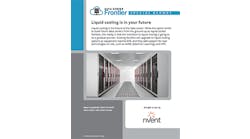In this week’s Voices of the Industry Jason Ferrara, Chief Marketing Officer of Aligned Data Centers, offers his view on the tipping point – cloud IaaS v. data center colocation.
Chief Marketing Officer of Aligned Data Centers
As with most things, there is no single “right” infrastructure solution for every company, or every application, at every time. Some companies, and some applications, will never work well in the cloud. Others will. Others work well in the cloud for a time – until they don’t. We call that moment the tipping point, when colocation becomes a better option than cloud-based infrastructure-as-a-service (IaaS).
When Cloud IaaS is the Best Option
One of the clearest use cases for cloud IaaS is application development and testing. In the cloud, the dev team can easily spin up a server with just a credit card. No need to request and provision new data center space, procure and install hardware …and no capital outlay. If the dev team breaks from the project for a while, no worries because the server capacity is pay-per-sip. And once ready, it’s easy to move the application into a test environment in the cloud and take as much capacity as necessary.
Maybe even after the application moves to production, cloud IaaS is the right infrastructure solution – it’s not yet clear how fast user adoption might grow or how much capacity will be needed. But at some point, the downsides of cloud IaaS become more apparent. Cost. Noisy neighbors. Availability. Then, moving the application into a data center colocation environment starts to make more sense.
Especially when that data center is cloud-like in its pricing model. When the data center offers truly flexible capacity in right-sized increments, on-demand. And when the data center’s network, with peering capabilities from public cloud to private infrastructure, makes moving from one to the other easy.
Outgrowing the Cloud
We’ve been hearing stories of companies that have reached the point where cloud doesn’t make sense anymore. In a trend referred to as “de-clouding” these companies are moving back to their own data centers, or to data center colocation. Here are two such stories.
For its first three years, the deal and coupon site relied on public cloud infrastructure-as-a-service. In 2011, the company’s user base reached a size where it made sense for Groupon to switch to a combination of its own data centers and colocation data centers.
Harmail Chatha, Groupon’s director of global data center operations, said, “It was not economically feasible for us to stay in the cloud.” Chatha said once a company starts to spend $200,000 to $250,000 per month in the cloud, they should look at the other options.
This Y Combinator graduate, which provides real-time databases for transactions and analytics, also relied on cloud IaaS at first. But about two years after the company’s 2011 launch, they moved most of their operation onto owned infrastructure. Founder Eric Frenkiel says they reached the point where physical machines were cheaper – much, much cheaper – than the virtual machines available from the cloud provider.
These experiences have a couple of important things in common. Groupon and MemSQL both relied on cloud IaaS when they were just starting out, didn’t have a lot of capital to invest in data center infrastructure, and needed the extreme flexibility and speed to market of the cloud. But once their applications (and businesses) matured, they moved to physical infrastructure.
Making the right decision
When a company “de-clouds” it’s most often not an indictment of the value of cloud IaaS, but a reflection of the maturity of the organization and/or its applications. The organization has “outgrown” the cloud and for one reason or another (often, cost efficiency) colocation becomes the better option.
What factors make cloud IaaS the “right” decision – or not? The Economist’s Intelligence Unit’s Mapping the Cloud Maturity Curve (pdf) survey of global IT leaders identified five fundamental components of a mature organizational approach to cloud computing:
- Aligned strategy – Align your cloud strategy to your business objectives
- Organizational harmony – Foster greater collaboration between business and IT
- Digital culture – Develop a culture that promotes the effective use of digital technology
- Dynamic infrastructure – Match your IT infrastructure to your business requirements
- Good governance – Develop the data governance processes required by cloud
Bottom line: Cloud IaaS is not a magic bullet. Neither is data center colocation. They are, rather, two tools available to businesses intent on growing, innovating, and delivering value to their customers. Right at some point, but not every point.
What’s your cloud story?
We’d love to hear how you made the cloud IaaS v. data center colocation decision – and how, perhaps, that decision has changed as you’ve grown. Join the conversation at facebook.com/AlignedDataCenters.
By Jason Ferrara, Chief Marketing Officer of Aligned Data Centers, the first data center colocation provider to offer a cloud-like model: pay-for-use pricing plus on-demand scalability.





